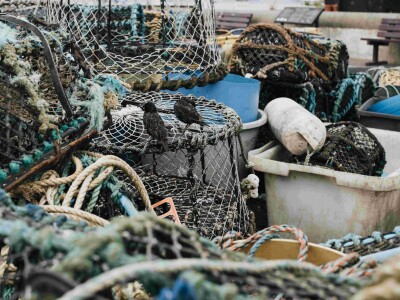Andy Wink, a well-known Alaska seafood economist, took the helm at the Bristol Bay Regional Seafood Development Association on July 23.
As incoming executive director, Wink replaced interim director Cameo Padilla, a stand-in for Becky Martello, who left the group earlier this year.
“Andy has nearly 10 years of experience in researching and analyzing the Alaska seafood industry, and comes to us with an extensive knowledge of the entire supply chain,” the group wrote in its announcement newsletter.
We spoke with Wink about fisheries data, the importance of the Bristol Bay association and its future plans:
What brought you to Alaska?
In 2003, I was working at the Chicago Board of Trade when my wife’s father got sick with cancer. He was a setnetter in Yakutat, and we moved to Juneau to be closer to him (unfortunately he passed away the next year, but we treasured the time we had with him).
How did you get into data analysis and then come to focus on fisheries?
I eventually went to work for the Alaska Department of Labor as an economist, and one of my first projects was to estimate employment in commercial fisheries. That led me down a deep rabbit hole where I had to learn the industry inside and out. From there, I got more and more involved in industry development until, in 2010, I went to work for McDowell Group where I provided analysis and consulting for the Alaska Seafood Marketing Institute. A few years later, I began providing sockeye market analysis for BBRSDA. In 2013, our family decided to move back to Minnesota (the state I grew up in). I offered to resign but was given the chance to continue working remotely, and it ended up working out just fine, as clients and coworkers were already scattered all over Alaska and the Pacific Northwest. When the former ED resigned from BBRSDA earlier this year, I decided to apply for the position.
What drew you to the BBRSDA? What role do you see the organization play in Alaska fisheries?
It’s such a productive fishery made up of truly remarkable people, the idea of telling their stories and working on their behalf is very exciting. Also, I felt like BBRSDA was doing a lot of productive work and saw a lot of opportunity in continuing those strategies — as well as developing some new ones.
In terms of the role the organization can play, there are situations where the fleet can be more effective speaking as one unified voice, and there are activities we can fund more efficiently as a single non-profit entity, as opposed to many individuals making similar, disconnected investments. Specifically, we have a well-conceived committee structure that endeavors to improve quality, conduct marketing, promote resource sustainability, and perform outreach — we can do things within each of those categories that contributes to the mission of raising the value of the fishery.
How do you see your background in data and analytics playing a role in your new position?
Spending most of my career analyzing seafood industry data has made me very adept at recognizing what is quantifiable and what is not — in addition to spotting good/bad data sources.
Everybody in the organization has heard the requests to quantify the impact of the BBRSDA, but that is not as simple as it sounds. There are so many variables involved in what we’re doing — versus what would have happened in the absence of our efforts — that I think it’s impossible to know exactly how much ex-vessel value is added to each pound.
What we do know is that we just wrapped up the fourth year in a row of 35 million-plus fish harvests and haven’t had an issue with inventory. This season produced one of the highest ex-vessel values ever (adjusting for inflation), and critical management activities have been sustained or enhanced in some cases despite the state’s fiscal problems. Obviously, luck always plays a role in market conditions because some things are outside of our control, but there’s plenty of design, too.
However, analytics will play a large role in the daily evaluation of project goals/opportunities. How much is achieved versus the spending required? If we remain vigilant about 1) being on point with the issues we work on (and there is a great process for doing that), 2) work with the right partners and 3) are pragmatic about evaluating future options and past performance, the ROI will take care of itself.
I’ll continue to report on market conditions and resource value allocation, but that service will probably evolve over time. Honestly, the BBRSDA already did a tremendous job of using the market analyses to support its activities and at least try to get ahead of problems (though some icebergs are just too big, as was the case in 2015).
What are some immediate and long-term challenges facing the BBRSDA?
In the short term, we have a fantastic problem: a lot of fish that will need to be sold/marketed ahead of next year.
In the long term, I’m very interested in finding ways we can promote efficiency in the supply chain and find ways to return a larger share of the resource pie to fishermen.
There’s been a lot of progress on improving quality, and we’ll continue to work with the fleet and processors on that aspect — in addition to promoting the gains that have been made on the quality front.
Finally, the issue of large-scale mining in the region is an immediate and long-term challenge. BBRSDA is prohibited from lobbying for or against resource allocation issues, but we can still be a very strong voice of opposition and provide information explaining what is at stake.
How can fishermen become involved in BBRSDA activities?
We have member meetings twice a year (one in the bay and one at Pacific Marine Expo) and we will probably be hosting some town hall events in the coming year for fishermen.
Aside from in-person events, there’s committee teleconferences and our phone/inbox is always open (contact info available on our website). You can follow us at on Facebook and sign up for our Waypoints email newsletter on our website.
I’m extremely interested in hearing from the fleet and would especially like to gather profiles, stories and media assets to help us meet our mission, in addition to ideas you might have about things we should work on. I am very keen on connecting sockeye consumers with this amazing fishery, but we need cooperation from the fleet. We’ve got a great food story to tell and plenty of high-powered contacts that want to tell that story, but we can’t do it alone.
Any big BBRSDA projects/issues happening now or coming soon?
We ran branded Bristol Bay sockeye promotions in 365 grocery stores during July and have a lot of interest from retailers in promoting refreshed product this fall/winter. The cost/benefit on these promotions and other marketing partnerships is looking really good.
For example, the Texas supermarket chain H-E-B likes our brand and story so much they are going to have seafood staff sporting Bristol Bay Sockeye branded aprons at more than 200 stores.
We also have eight discounted RSW units left to sell and are working with Doug Cannon and Mendi Jenkins from Marine Refrigeration Solutions to provide free boat consultations. Please get a hold of us if you’re interested in buying one of those. There are many other things in the works which we’ll be fine tuning this fall.







